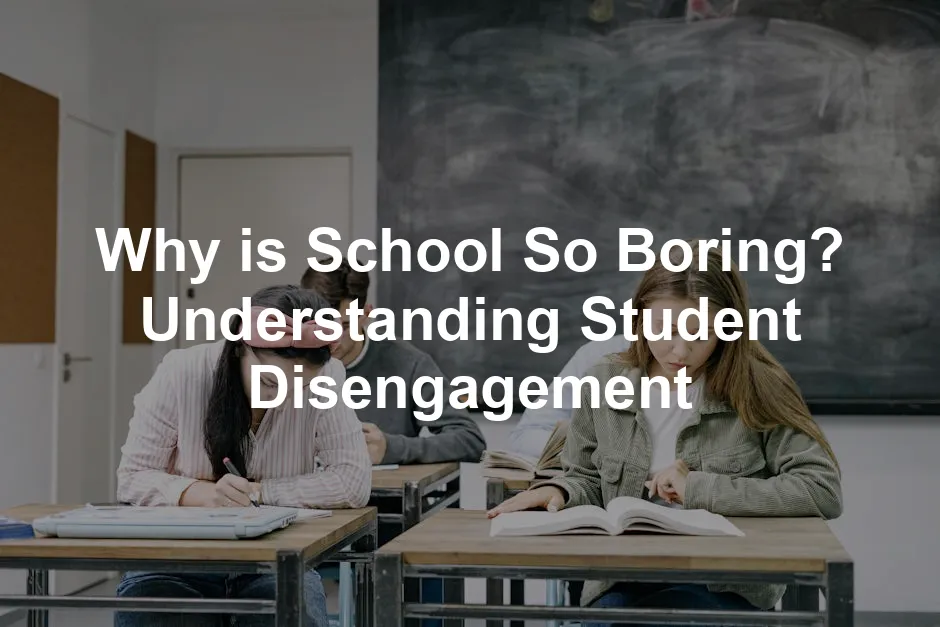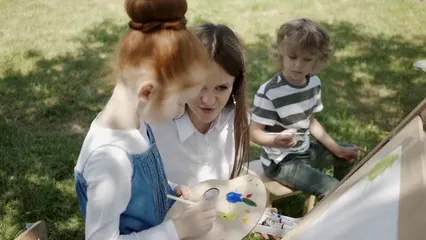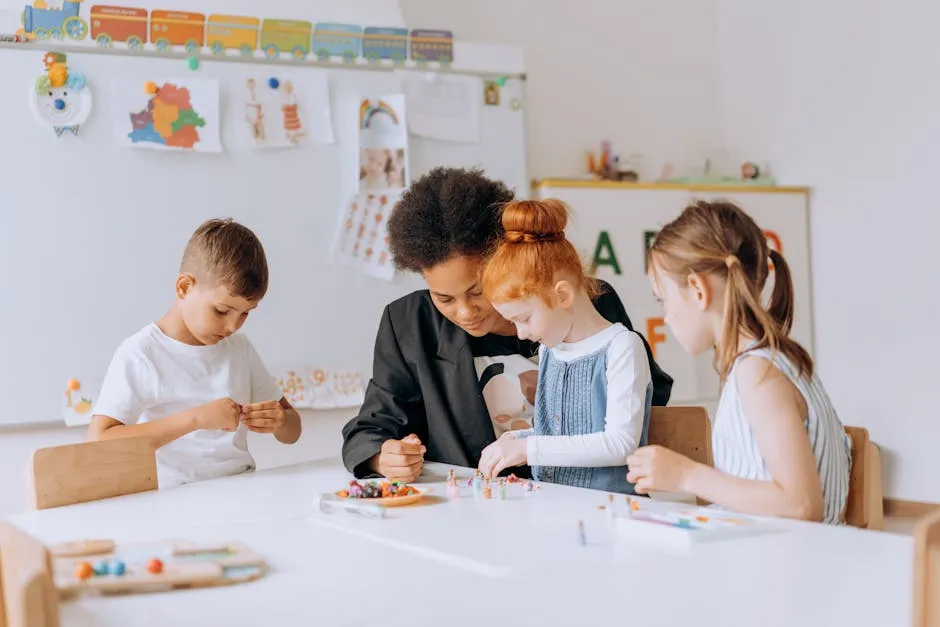
Why is School So Boring? Understanding Student Disengagement
Introduction
Boredom in school is a common experience. Many students feel this way, impacting their learning and motivation. This article aims to uncover the reasons behind school boredom and suggest potential solutions.
Summary and Overview
Several factors contribute to student boredom in school. First, a lack of challenge can leave students feeling unengaged. Additionally, busywork often replaces meaningful tasks, stifling creativity. The relevance of the curriculum plays a crucial role; when students can’t see how lessons apply to their lives, interest wanes.
Addressing boredom is vital for both students and educators. Prolonged boredom can lead to disengagement, higher dropout rates, and a negative perception of education. By understanding these factors, we can work toward creating a more engaging school environment. In the following sections, we will explore these reasons in detail and discuss effective strategies to combat boredom in schools.

The Reasons Behind School Boredom
1. Lack of Challenge
Many students feel bored when the material is too easy. It’s essential to engage students within their Zone of Proximal Development (ZPD). This concept refers to the sweet spot where learners are challenged just enough to encourage growth. If the work is too simple, students lose interest quickly.
Interestingly, both gifted and struggling students can experience boredom. Gifted students may find themselves waiting for others to catch up. Struggling students can feel overwhelmed if the challenges are too steep. In both cases, finding the right level of difficulty is key. When students are appropriately challenged, they are more likely to stay engaged and motivated.
To make learning more engaging, consider incorporating STEM Activity Kits. These kits provide hands-on challenges that can captivate students’ interests while encouraging critical thinking and problem-solving skills.

2. Busywork vs. Meaningful Tasks
Busywork is a common culprit in schools, often leading to student disinterest. This type of work consists of tasks that seem pointless, like filling out repetitive worksheets. These assignments can stifle creativity and waste valuable learning time.
In contrast, meaningful tasks offer hands-on learning experiences. When students engage in projects that connect to their interests, they feel more invested. For example, instead of busy worksheets, students could create presentations or collaborate on group projects. This shift encourages critical thinking and sparks curiosity. When students find purpose in their tasks, boredom takes a backseat.
One excellent way to foster creativity is through DIY Craft Kits. These kits inspire hands-on creativity, allowing students to explore their artistic side while learning valuable skills.

3. Relevance of Curriculum
Many students often question the relevance of their school lessons. They wonder, “When will I ever use this in real life?” This feeling can lead to boredom and disengagement. It’s crucial for educators to connect lessons to real-world applications. When students see how their studies relate to their daily lives, they are more likely to stay engaged.
Project-based learning serves as an effective solution. This method allows students to work on meaningful projects that spark their interests. For instance, instead of just learning about ecosystems from a textbook, students could create a community garden. Such hands-on projects make learning more relatable and exciting. By focusing on relevance, we can transform education into an engaging experience for students.
To enhance this experience, consider using Interactive Globes. They provide a fun, visual way for students to learn about geography and cultures around the world, making lessons come alive.

4. Classroom Environment
The classroom environment significantly impacts student engagement. A dull, rigid atmosphere can make even the most interesting subjects feel tedious. Students thrive in interactive and collaborative learning spaces. When they can work together, share ideas, and participate actively, boredom tends to fade away.
Seating arrangements also play a vital role. Traditional rows of desks can create a sense of isolation. In contrast, arranging desks in groups fosters collaboration and communication. Additionally, effective classroom management encourages a positive vibe. When students feel comfortable in their environment, they are more likely to participate actively. Creating a welcoming classroom can make learning more enjoyable and engaging.

Adding some Classroom Poster Sets can also brighten up the walls and create a more stimulating learning environment. They can serve as visual aids that reinforce learning while keeping the classroom lively.
5. Teacher Engagement
Teacher enthusiasm greatly influences student engagement. When teachers are passionate, their energy can be contagious. Students often mirror this enthusiasm. A lively teaching style encourages participation and curiosity. Conversely, a lack of enthusiasm can lead to boredom.
Strong teacher-student relationships also boost motivation. When students feel supported, they’re more likely to engage. For instance, a teacher who knows their students’ interests can tailor lessons accordingly. This personal touch can make a significant difference.
Effective teaching strategies include interactive lessons and group activities. For example, incorporating discussions and hands-on projects can ignite interest. Using technology, like Educational Board Games, can also enhance engagement. These games provide a fun way for students to learn while interacting with each other.

6. Peer Connections
Social dynamics play a crucial role in how students feel about school. Positive peer relationships can make school more enjoyable. Students often thrive in environments where they feel connected to others. In contrast, isolation can lead to feelings of boredom.
A lack of connection with peers can make school feel tedious. Students who feel alone may disengage from classroom activities. They might find it hard to participate when they don’t have friends nearby.
To foster a sense of community, teachers can encourage group projects and collaborative work. Creating opportunities for students to share their interests can also help build connections. Organizing social events or team-building activities can strengthen these relationships. When students feel a sense of belonging, school becomes a more engaging place.

7. Mental Health Considerations
Boredom in school can signal underlying mental health issues. For some students, feelings of anxiety, depression, or stress manifest as disinterest in their studies. When students struggle with these challenges, school can feel overwhelming and uninviting.
It’s essential for schools to address mental health proactively. Educators and staff should foster environments where students feel safe discussing their feelings. This support can help reduce feelings of isolation and encourage engagement in learning. Understanding emotional responses is crucial for mental health, as it can directly affect students’ academic performance and social interactions.

Recognizing and addressing mental health concerns is crucial for creating a more engaging school experience. why understanding emotional responses is crucial for mental health
8. Extracurricular Engagement
Extracurricular activities play a vital role in enhancing the school experience. These activities, such as clubs, sports, and arts, provide students with opportunities to connect with peers and develop new skills. Engaging in these activities can make school feel more enjoyable and less monotonous.
Participation in clubs fosters a sense of belonging and community. Students can explore interests outside the classroom, which can spark passion and motivation. Additionally, sports teach teamwork and discipline, valuable skills for life.
Encouraging students to get involved can be as simple as promoting school events or sharing personal interests. Schools can also create diverse options to cater to various interests. By embracing extracurricular activities, students can transform their school experience from boring to vibrant.

To keep students engaged, consider offering Subscription Boxes for Kids. These boxes can provide new and exciting activities each month, keeping students curious and engaged.

Conclusion
In summary, boredom in schools stems from various factors, including a lack of challenge, busywork, and mental health issues. Addressing these concerns is vital for improving educational outcomes. Collaboration between students, teachers, and parents can foster a more engaging learning environment. Together, we can create schools where students feel excited and motivated to learn.
Please let us know what you think about our content by leaving a comment down below!
Thank you for reading till here 🙂
All images from Pexels




